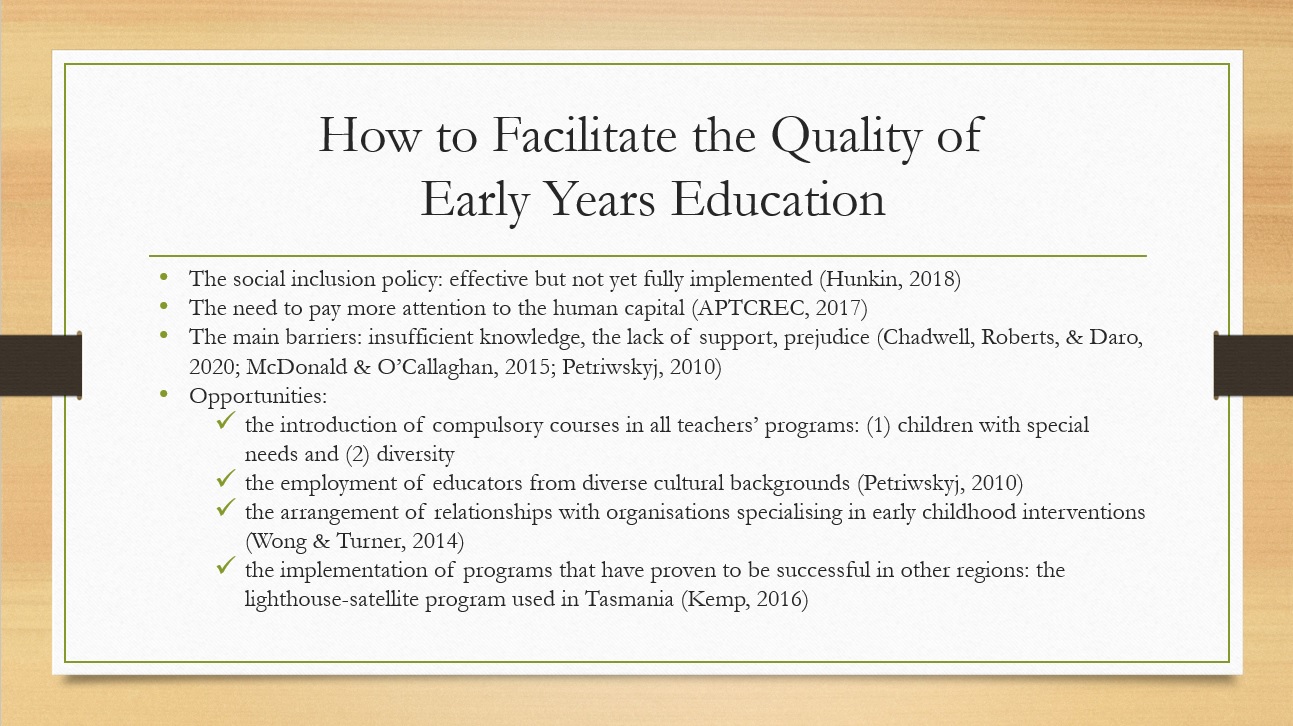The Oral Presentation
The issue of interest is to develop a deeper understanding of the strengths and weaknesses of the social inclusion policy. According to Hunkin (2018), the problem of the current early education system is that quality is identified with governmental investment rather than human capital. Meanwhile, specialists in social work and pedagogy argue that the system of early education should be repoliticised (APTCREC, 2017). Currently, Australian early childhood programs meet such obstacles as negative attitudes and limited knowledge of the staff, as well as insufficient support (Chadwell, Roberts, & Daro, 2020; McDonald & O’Callaghan, 2015; Petriwskyj, 2010). It is essential to implement the inclusion policy because children coming from diverse ethnic backgrounds and living in low-income families cannot reach their full potential (“Statement on the inclusion,” n.d.). According to UNESCO (2009), an inclusive education system can be created on the condition that schools become willing and able to educate all children in the community. Hence, it is crucial to promote the quality of the inclusion policy and increase coordination between families, communities, and schools.
The analysis of scholarly sources and governmental documents indicates that at present, social inclusion in Australia is not developed to the necessary extent. The focus of the policy is on including children in social groups instead of in a “social policy sense” (Wong & Turner, 2014, p. 62). There exists a number of intervention services for children with disabilities (Kemp, 2016). However, the concept of quality as a discourse needs to change its character from a reflective to an active one (Lyons, 2013). The Department of Education and Training (2017) emphasizes the need for schools to make sure that no one violates the right of every child to be happy and receive an education. One of the necessary prerequisites of gaining this aim is helping children from low-income families to get access to breakfast clubs and bus services so that they would not experience difficulty communing with and staying at school (Fenech & Skattebol, 2019). Therefore, the social inclusion policy should concentrate not only on children with disabilities.
To avoid the mentioned challenges, it is necessary to utilise the existing strengths and make way for new ones. Specifically, educators should be encouraged to engage in learning how to work with the inclusion policy (Pelatti, Dynia, Logan, Justice, & Kaderavek, 2016). What is even more important, teachers should feel support from communities and the government in case they feel the lack of knowledge or understanding on how to implement the policy. Such measures as employing educators from diverse backgrounds, providing children with subsidies, offering occupation therapy and language pathologist’s help can increase the effectiveness of the social inclusion policy to a great extent.
The PowerPoint Slide

References
APTCREC. (2017). EECERA 2017 keynote I – Michel Vandenbroeck [Video file]. Web.
Chadwell, M. R., Roberts, A. M., & Daro, A. M. (2020). Ready to teach all children? Unpacking early childhood educators’ feelings of preparedness for working with children with disabilities. Early Education and Development, 31(1), 100-112. Web.
Department of Education and Training. (2017). Inclusive education policy. Web.
Fenech, M., & Skattebol, J. (2019). Supporting the inclusion of low-income families in early childhood education: An exploration of approaches through a social justice lens. International Journal of Inclusive Education. Web.
Hunkin, E. (2019). If not quality, then what? The discursive risks in early childhood quality reform. Discourse: Studies in the Cultural Politics of Education, 40(6), 917-929. Web.
Kemp, C. R. (2016). Early childhood inclusion in Australia. Infants & Young Children, 29(3), 178-187. Web.
Lyons, L. (2013). Transformed understanding or enlightened ableism? The gap between policy and practice for children with disabilities in Aotearoa New Zealand. International Journal of Early Childhood, 45, 237-249. Web.
McDonald, D., & O’Callaghan, K. (2015). Developing synergies between the National disability insurance scheme and the Victorian government school system. Web.
Pelatti, C. Y., Dynia, J. M., Logan, J. A. R., Justice, L. M., & Kaderavek, J. (2016). Examining quality in two preschool settings: Publicly funded early childhood education and inclusive early childhood education classrooms. Child & Youth Care Forum, 45, 829-849. Web.
Petriwskyj, A. (2010). Who has rights to what? Inclusion in Australian early childhood programs. Contemporary Issues in Early Childhood, 11(4). Web.
Statement on the inclusion of every child in early childhood education and care. (n.d.). Web.
UNESCO. (2009). Policy guidelines on inclusion in education. Web.
Wong, S., & Turner, K. (2014). Constructions of social inclusion within Australian early childhood education and care policy documents. Contemporary Issues in Early Childhood, 15(1), 54-68. Web.
